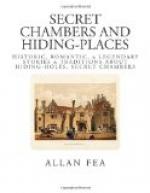[Footnote 1: See Life of John Gerard, p. 386.]
At Hackney the Vaux family had another, residence with its chapel and “priest’s hole,” the latter having a masked entrance high up in the wall, which led to a space under a gable projection of the roof. For double security this contained yet an inner hiding-place. In the existing Brooke House are incorporated the modernised remains of this mansion.
CHAPTER IV
THE GUNPOWDER PLOT CONSPIRATORS
Lord Vaux of Harrowden, Sir William Catesby of Ashby St. Ledgers, and Sir Thomas Tresham of Rushton Hall (all in Northamptonshire) were upon more than one occasion arraigned before the Court of the Star Chamber for harbouring Jesuits. The old mansions Ashby St. Ledgers and Rushton fortunately still remain intact and preserve many traditions of Romanist plots. Sir William Catesby’s son Robert, the chief conspirator, is said to have held secret meetings in the curious oak-panelled room over the gate-house of the former, which goes by the name of “the Plot Room.” Once upon a time it was provided with a secret means of escape. At Rushton Hall a hiding-place was discovered in 1832 behind a lintel over a doorway; it was full of bundles of manuscripts, prohibited books, and incriminating correspondence of the conspirator Tresham. Another place of concealment was situated in the chimney of the great hall and in this Father Oldcorn was hidden for a time. Gayhurst, or Gothurst, in Buckinghamshire, the seat of Sir Everard Digby, also remains intact, one of the finest late Tudor buildings in the country; unfortunately, however, only recently a remarkable “priest’s hole” that was here has been destroyed in consequence of modern improvements. It was a double hiding-place, one situated beneath the other; the lower one being so arranged as to receive light and air from the bottom portion of a large mullioned window—a most ingenious device. A secret passage in the hall had communication with it, and entrance was obtained through part of the flooring of an apartment, the movable part of the boards revolving upon pivots and sufficiently solid to vanquish any suspicion as to a hollow space beneath.
[Illustration: ASHBY ST. LEDGERS, NORTHAMPTONSHIRE]
[Illustration: THE PLOT ROOM, ASHBY ST. LEGERS]
As may be supposed, tradition says that at the time of Digby’s arrest he was dragged forth from this hole, but history shows that he was taken prisoner at Holbeach House (where, it will be remembered, the conspirators Catesby and Percy were shot), and led to execution. For a time Digby sought security at Coughton Court, the seat of the Throckmortons, in Warwickshire. The house of this old Roman Catholic family, of course, had its hiding-holes, one of which remains to this day. Holbeach as well as Hagley Hall, the homes of the Litteltons, have been rebuilt. The latter was pulled down in the middle of the eighteenth century. Here it was that Stephen Littleton and Robert Winter were captured through the treachery of the cook. Grant’s house, Norbrook, in Warwickshire, has also given way to a modern one.




